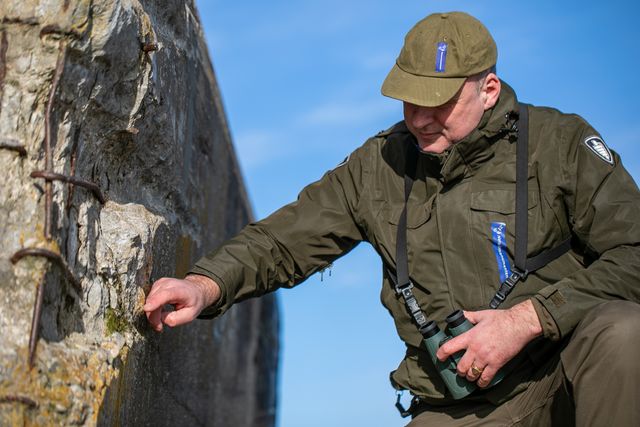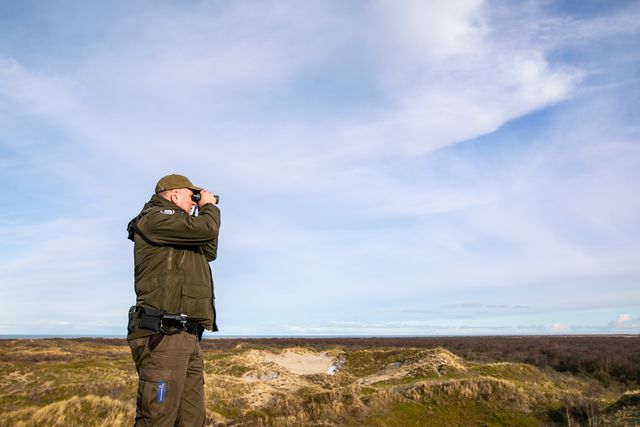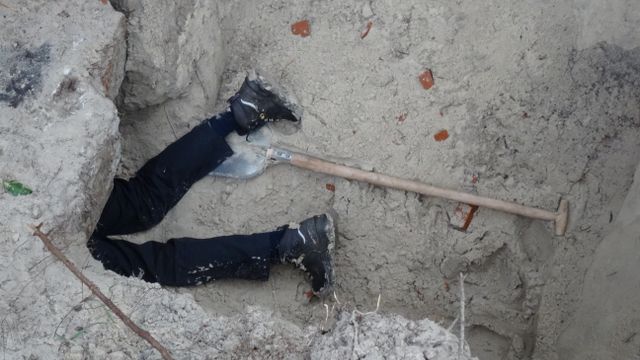The nature in the Wadden area took a real beating due to the construction of the Atlantic Wall. The tranquillity was disrupted, the habitats of plants and animals destroyed and the dunes were weakened. Yet nature fought back, ultimately reclaiming its rightful territory. Some species have even made the bunkers their homes or safe havens. Forest ranger Jan Willem Zwart jumps on his bike and shows us this on Schiermonnikoog.
At the edge of the village, Jan Willem Zwart steps off for a minute, as he will often do along this bunker route. He points; there was a huge mess tent there during the war years. Now there's just a small mound in the grass between the Badweg and the skating rink. And from the bike path in the dunes, you have to look very closely to see any traces of the Atlantic Wall. Both rubble and complete bunkers lay hidden in the landscape, most under thick layers of sand and vegetation after all these years.

A piece of cement sticks out here and there. Jan Willem gets off his bike again and points out a little hole covered in reed behind a small dune. There has to be an entrance to a bunker there. Further on, he picks up a pork rib protruding from the disturbed sand between bits of broken crockery. Rubbish, dug up by 'treasure hunters'. “Not quite what they were hoping for. But there must have been a kitchen here somewhere.”
“ The beautiful thing is that nature just takes over again ”
And going further into the dunes – “Watch out for that hole” – it seems the Atlantic Wall is everywhere. Foxholes, ammunition bunkers, a communication post and all kinds of other bunkers are hidden in and under a large part of the dunes. “But the beautiful thing is that nature just takes over again.”
Coastal dunes are rare
Thank goodness, because even though we are used to sandy beaches and dunes, coastal dunes are quite rare worldwide. And to think that hundreds of species of plants and animals live in those dunes. Jan Willem loves the fact that as the coordinator for managing Natuurmonumenten on Schiermonnikoog, he can contribute to maintaining this nature reserve. And that includes the military heritage.

Attack
In the first instance, the arrival of the German military was an attack on nature. Because the Atlantic Wall was to remain hidden from their enemies, the buildings were embedded in the environment as much as possible. With all that sand and the differences in height, the dunes were ideal. A great deal of soil was stripped to create walls for trenches, and the dunes (created by years of interplay between the wind and, among others, reed) were buried, displaced or built on.
The Wassermann bunker, for example, that still stands proud atop the highest dune on Schiermonnikoog. “To build it they first dug off metres of the dune and then used the adjacent dune to bury the bunker,” says Jan Willem. Without reed to retain the sand, this caused the sand to form rifts even faster. Other bunkers were covered with camouflage nets or shrubs. A lot of bunkers were built, even an entire bunker village. Plants and animals paid a high price.
“ The adjacent bunker was used to cover the Wassermannbunker ”
Who would have thought that all that concrete, those damp, often underground buildings that were mostly inaccessible to people would become important places for a number of animal species? Bats, for example, who use them to hibernate and mate. But also butterflies, wild bees, other insects and amphibians such as salamanders use them. Some animals don't mind the presence of humans, like in Museumbunker Schlei. “Look, there are some swallows' nests up there,” says Jan Willem. And below them a number of pellets indicate the presence of - probably - barn owls.
Picky
Even the rather picky lichen finds a spot: on weathered concrete, where the temperature is just right, there is enough sunlight and clean air, and it's nice and dry. But speaking of nature and the Atlantic Wall, there is another advantage. Jan Willem grabs his binoculars, filled with delight as he climbs the Wassermann bunker: the roof offers phenomenal views of Schiermonnikoog's nature.



